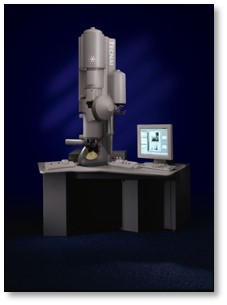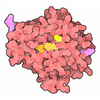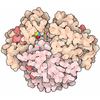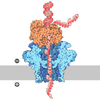+ Open data
Open data
- Basic information
Basic information
| Entry | Database: PDB / ID: 5aef | ||||||
|---|---|---|---|---|---|---|---|
| Title | Electron cryo-microscopy of an Abeta(1-42)amyloid fibril | ||||||
 Components Components | AMYLOID BETA A4 PROTEIN | ||||||
 Keywords Keywords | PROTEIN FIBRIL / ALZHEIMER'S DISEASE / AMYLOID FIBRIL / PROTEIN AGGREGATION / PROTEIN FOLDING / CROSS-BETA / FREALIX | ||||||
| Function / homology |  Function and homology information Function and homology informationamyloid-beta complex / growth cone lamellipodium / cellular response to norepinephrine stimulus / growth cone filopodium / microglia development / collateral sprouting in absence of injury / Formyl peptide receptors bind formyl peptides and many other ligands / axo-dendritic transport / regulation of Wnt signaling pathway / regulation of synapse structure or activity ...amyloid-beta complex / growth cone lamellipodium / cellular response to norepinephrine stimulus / growth cone filopodium / microglia development / collateral sprouting in absence of injury / Formyl peptide receptors bind formyl peptides and many other ligands / axo-dendritic transport / regulation of Wnt signaling pathway / regulation of synapse structure or activity / axon midline choice point recognition / astrocyte activation involved in immune response / NMDA selective glutamate receptor signaling pathway / regulation of spontaneous synaptic transmission / mating behavior / growth factor receptor binding / peptidase activator activity / Golgi-associated vesicle / PTB domain binding / positive regulation of amyloid fibril formation / Insertion of tail-anchored proteins into the endoplasmic reticulum membrane / astrocyte projection / Lysosome Vesicle Biogenesis / neuron remodeling / Deregulated CDK5 triggers multiple neurodegenerative pathways in Alzheimer's disease models / nuclear envelope lumen / dendrite development / positive regulation of protein metabolic process / TRAF6 mediated NF-kB activation / signaling receptor activator activity / Advanced glycosylation endproduct receptor signaling / negative regulation of long-term synaptic potentiation / modulation of excitatory postsynaptic potential / main axon / transition metal ion binding / The NLRP3 inflammasome / regulation of multicellular organism growth / intracellular copper ion homeostasis / ECM proteoglycans / regulation of presynapse assembly / positive regulation of T cell migration / neuronal dense core vesicle / Purinergic signaling in leishmaniasis infection / positive regulation of chemokine production / cellular response to manganese ion / Notch signaling pathway / clathrin-coated pit / extracellular matrix organization / neuron projection maintenance / astrocyte activation / ionotropic glutamate receptor signaling pathway / positive regulation of calcium-mediated signaling / Mitochondrial protein degradation / positive regulation of mitotic cell cycle / axonogenesis / protein serine/threonine kinase binding / response to interleukin-1 / platelet alpha granule lumen / cellular response to copper ion / cellular response to cAMP / positive regulation of glycolytic process / central nervous system development / dendritic shaft / trans-Golgi network membrane / endosome lumen / positive regulation of long-term synaptic potentiation / adult locomotory behavior / positive regulation of interleukin-1 beta production / learning / Post-translational protein phosphorylation / positive regulation of JNK cascade / locomotory behavior / serine-type endopeptidase inhibitor activity / microglial cell activation / positive regulation of non-canonical NF-kappaB signal transduction / cellular response to nerve growth factor stimulus / TAK1-dependent IKK and NF-kappa-B activation / regulation of long-term neuronal synaptic plasticity / recycling endosome / synapse organization / visual learning / response to lead ion / positive regulation of interleukin-6 production / Golgi lumen / cognition / Regulation of Insulin-like Growth Factor (IGF) transport and uptake by Insulin-like Growth Factor Binding Proteins (IGFBPs) / endocytosis / cellular response to amyloid-beta / neuron projection development / positive regulation of inflammatory response / positive regulation of tumor necrosis factor production / Platelet degranulation / heparin binding / regulation of translation / growth cone / regulation of gene expression / early endosome membrane / G alpha (i) signalling events / perikaryon / G alpha (q) signalling events Similarity search - Function | ||||||
| Biological species |  HOMO SAPIENS (human) HOMO SAPIENS (human) | ||||||
| Method | ELECTRON MICROSCOPY / helical reconstruction / cryo EM / Resolution: 5 Å | ||||||
 Authors Authors | Schmidt, M. / Rohou, A. / Lasker, K. / Yadav, J.K. / Schiene-Fischer, C. / Fandrich, M. / Grigorieff, N. | ||||||
 Citation Citation |  Journal: Proc Natl Acad Sci U S A / Year: 2015 Journal: Proc Natl Acad Sci U S A / Year: 2015Title: Peptide dimer structure in an Aβ(1-42) fibril visualized with cryo-EM. Authors: Matthias Schmidt / Alexis Rohou / Keren Lasker / Jay K Yadav / Cordelia Schiene-Fischer / Marcus Fändrich / Nikolaus Grigorieff /   Abstract: Alzheimer's disease (AD) is a fatal neurodegenerative disorder in humans and the main cause of dementia in aging societies. The disease is characterized by the aberrant formation of β-amyloid (Aβ) ...Alzheimer's disease (AD) is a fatal neurodegenerative disorder in humans and the main cause of dementia in aging societies. The disease is characterized by the aberrant formation of β-amyloid (Aβ) peptide oligomers and fibrils. These structures may damage the brain and give rise to cerebral amyloid angiopathy, neuronal dysfunction, and cellular toxicity. Although the connection between AD and Aβ fibrillation is extensively documented, much is still unknown about the formation of these Aβ aggregates and their structures at the molecular level. Here, we combined electron cryomicroscopy, 3D reconstruction, and integrative structural modeling methods to determine the molecular architecture of a fibril formed by Aβ(1-42), a particularly pathogenic variant of Aβ peptide. Our model reveals that the individual layers of the Aβ fibril are formed by peptide dimers with face-to-face packing. The two peptides forming the dimer possess identical tilde-shaped conformations and interact with each other by packing of their hydrophobic C-terminal β-strands. The peptide C termini are located close to the main fibril axis, where they produce a hydrophobic core and are surrounded by the structurally more flexible and charged segments of the peptide N termini. The observed molecular architecture is compatible with the general chemical properties of Aβ peptide and provides a structural basis for various biological observations that illuminate the molecular underpinnings of AD. Moreover, the structure provides direct evidence for a steric zipper within a fibril formed by full-length Aβ peptide. | ||||||
| History |
| ||||||
| Remark 700 | SHEET DETERMINATION METHOD: DSSP THE SHEETS PRESENTED AS "BA" IN EACH CHAIN ON SHEET RECORDS BELOW ... SHEET DETERMINATION METHOD: DSSP THE SHEETS PRESENTED AS "BA" IN EACH CHAIN ON SHEET RECORDS BELOW IS ACTUALLY AN 3-STRANDED BARREL THIS IS REPRESENTED BY A 4-STRANDED SHEET IN WHICH THE FIRST AND LAST STRANDS ARE IDENTICAL. |
- Structure visualization
Structure visualization
| Movie |
 Movie viewer Movie viewer |
|---|---|
| Structure viewer | Molecule:  Molmil Molmil Jmol/JSmol Jmol/JSmol |
- Downloads & links
Downloads & links
- Download
Download
| PDBx/mmCIF format |  5aef.cif.gz 5aef.cif.gz | 30.5 KB | Display |  PDBx/mmCIF format PDBx/mmCIF format |
|---|---|---|---|---|
| PDB format |  pdb5aef.ent.gz pdb5aef.ent.gz | 22.1 KB | Display |  PDB format PDB format |
| PDBx/mmJSON format |  5aef.json.gz 5aef.json.gz | Tree view |  PDBx/mmJSON format PDBx/mmJSON format | |
| Others |  Other downloads Other downloads |
-Validation report
| Summary document |  5aef_validation.pdf.gz 5aef_validation.pdf.gz | 603.6 KB | Display |  wwPDB validaton report wwPDB validaton report |
|---|---|---|---|---|
| Full document |  5aef_full_validation.pdf.gz 5aef_full_validation.pdf.gz | 610.1 KB | Display | |
| Data in XML |  5aef_validation.xml.gz 5aef_validation.xml.gz | 13.7 KB | Display | |
| Data in CIF |  5aef_validation.cif.gz 5aef_validation.cif.gz | 19.1 KB | Display | |
| Arichive directory |  https://data.pdbj.org/pub/pdb/validation_reports/ae/5aef https://data.pdbj.org/pub/pdb/validation_reports/ae/5aef ftp://data.pdbj.org/pub/pdb/validation_reports/ae/5aef ftp://data.pdbj.org/pub/pdb/validation_reports/ae/5aef | HTTPS FTP |
-Related structure data
| Related structure data |  3132MC M: map data used to model this data C: citing same article ( |
|---|---|
| Similar structure data | Similarity search - Function & homology  F&H Search F&H Search |
- Links
Links
- Assembly
Assembly
| Deposited unit | 
|
|---|---|
| 1 |
|
- Components
Components
| #1: Protein/peptide | Mass: 2835.365 Da / Num. of mol.: 2 / Fragment: ABETA, UNP RESIDUES 630-657 / Source method: obtained synthetically / Source: (synth.)  HOMO SAPIENS (human) / References: UniProt: E9PG40, UniProt: P05067*PLUS HOMO SAPIENS (human) / References: UniProt: E9PG40, UniProt: P05067*PLUS |
|---|
-Experimental details
-Experiment
| Experiment | Method: ELECTRON MICROSCOPY |
|---|---|
| EM experiment | Aggregation state: FILAMENT / 3D reconstruction method: helical reconstruction |
- Sample preparation
Sample preparation
| Component | Name: ABETA(1-42) AMYLOID-LIKE FIBRIL / Type: COMPLEX / Details: FIBRIL |
|---|---|
| Buffer solution | Name: 50MM TRIS-HCL / pH: 7.4 / Details: 50MM TRIS-HCL |
| Specimen | Conc.: 1 mg/ml / Embedding applied: NO / Shadowing applied: NO / Staining applied: NO / Vitrification applied: YES |
| Specimen support | Details: HOLEY CARBON |
| Vitrification | Instrument: GATAN CRYOPLUNGE 3 / Cryogen name: ETHANE / Details: 4 SEC BACKSIDE BLOTTING |
- Electron microscopy imaging
Electron microscopy imaging
| Experimental equipment |  Model: Tecnai F30 / Image courtesy: FEI Company |
|---|---|
| Microscopy | Model: FEI TECNAI F30 / Date: Feb 5, 2010 |
| Electron gun | Electron source:  FIELD EMISSION GUN / Accelerating voltage: 300 kV / Illumination mode: FLOOD BEAM FIELD EMISSION GUN / Accelerating voltage: 300 kV / Illumination mode: FLOOD BEAM |
| Electron lens | Mode: BRIGHT FIELD / Nominal magnification: 59000 X / Calibrated magnification: 58333 X / Nominal defocus max: 3000 nm / Nominal defocus min: 1750 nm / Cs: 2 mm |
| Specimen holder | Temperature: 100 K |
| Image recording | Electron dose: 30 e/Å2 / Film or detector model: KODAK SO-163 FILM |
| Image scans | Num. digital images: 29 |
- Processing
Processing
| EM software | Name: FREALIX / Category: 3D reconstruction | ||||||||||||
|---|---|---|---|---|---|---|---|---|---|---|---|---|---|
| CTF correction | Details: INDIVIDUAL HELICAL SUBUNITS | ||||||||||||
| 3D reconstruction | Method: PROJECTION MATCHING AND FOURIER INVERSION / Resolution: 5 Å / Num. of particles: 62320 / Actual pixel size: 1.2 Å Details: FINAL MAP WAS CALCULATED FROM 29 SINGLE FILAMENT RECONSTRUCTIONS. DATA USED FOR REFINEMENT WAS NEVER BELOW 10 ANGSTROM RESOLUTION. RESOLUTION OF FIBRIL CORE IS ABOUT 5 ANGSTROM. 3 POSSIBLE ...Details: FINAL MAP WAS CALCULATED FROM 29 SINGLE FILAMENT RECONSTRUCTIONS. DATA USED FOR REFINEMENT WAS NEVER BELOW 10 ANGSTROM RESOLUTION. RESOLUTION OF FIBRIL CORE IS ABOUT 5 ANGSTROM. 3 POSSIBLE MODELS FOR THE CENTRAL REGION OF A ABETA(1-42) FIBRIL RECONSTRUCTION. MODEL1 ABETA(17-42) MODEL2 ABETA( 16-41) MODEL3 ABETA(15-40) SUBMISSION BASED ON EXPERIMENTAL DATA FROM EMDB EMD-3132. (DEPOSITION ID: 13698). Symmetry type: HELICAL | ||||||||||||
| Atomic model building | Protocol: OTHER / Space: REAL / Target criteria: ELECTRON DENSITY / Details: METHOD--DIREX REFINEMENT PROTOCOL--PEPTIDE CHAIN | ||||||||||||
| Refinement | Highest resolution: 5 Å | ||||||||||||
| Refinement step | Cycle: LAST / Highest resolution: 5 Å
|
 Movie
Movie Controller
Controller



 PDBj
PDBj














